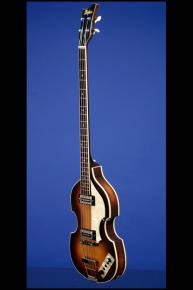A Fine and Totally Original Mid-Seventies Hofner 500/1 Violin Bass
1974 HOFNER 500/1 "VIOLIN" BAR-BLADE PICKUP BASS
This near mint and totally original mid-seventies Hofner 500/1 "Violin" bass weighs just 4.00 lbs and has a two-inch thick, ten and three-quarters inch wide, 'violin' shaped full hollow-body with a two-piece spruce top. Flat' two-piece book-matched laminated maple back and triple-bound laminated maple sides. Thirty-inch scale one-piece maple neck with a nut width of 1 9/16 inches and a really fat profile. Rosewood fretboard with a 'zero' plus twenty-two original 'medium' frets and mother-of-pearl dot position markers. Individual 'Kolb' closed-back tuners with squared-off white plastic oval buttons. Black laminated headstock face with 'flat' Hofner script peghead logo in gold. Two Hofner black plastic bodied single coil "Bar-blade" (shark-fin) pickups with individual height adjustments and outputs of 5.63k and 5.85k. Two 'rotary' volume controls and three two-way 'slider' switches for "Rhythm/Solo", "Bass" and "Treble". Hofner black plastic control knobs with ribbed sides and metal tops, all on a 'wide' rectangular mother-of-pearl base with black edging. The original potentiometers are made by 'Preh' and are all stamped "714". Original three-ply 'mother-of-pearl' pickguard. 'Floating' four-saddle ebony bridge with ebony base with four 'friction-fit' moveable saddles. Hofner specific nickel 'trapeze' style tailpiece with "Made in West Germany" stamped on the end. Apart from a few tiny and insignificant marks on the back of the neck this fantastic bass in is truly near mint (9.25) condition. Housed in a modern rectangular three-latch black hardshell case with black plush lining (9.25).
This is a superb example of a mid seventes "Beatle" Bass… Walter Hofner conceived of the idea of a short scale violin shaped hollow electric bass guitar in 1955 and introduced the finished product at the Frankfurt trade show in 1956. It was most certainly based on the Gibson EB-1 which was commonly called the Gibson Electric Bass. The measurements are very similar, the Gibson having an 18 7/8 inch long body (Hofner 18 inches); the Gibson body width 11 1/4 inches (Hofner 10 3/4 inches); the Gibson body thickness 2 inches (Hofner 1 3/4 inches); the Gibson scale length 30 1/2 inches (Hofner 30 inches). That famous bass was introduced in 1953 and also featured a 'violin-shaped' body - but was made of solid mahogany and featured a telescopic end-pin for playing bass upright style.
This 1970 example features the two Hofner black plastic bodied single coil "Bar-blade" (shark-fin) pickups, which were introduce in late 1967. They were 'upgraded' versions of the 'Staple-Top' pickups, which when notes were bent, volume was not lost.
"Founded in Schonbach in 1887 by master luthier Karl Hofner, the company became the largest manufacturer of stringed and fretted instruments in Germany. Craft skills and business initiative laid the foundation for a reputation that, even before World War I, extended far beyond the borders of Germany. His two sons, Josef and Walter, joined their father's company in 1919 and 1921 respectively. They successfully expanded Hofner's worldwide market, enabling them to survive the years of recovery, which marked the phase after World War II and the related resettlement from the "Sudetenland" to Bavaria. In 1950, new production facilities were built in Bubenreuth.
To date, more than two million stringed and fretted instruments - from student to master models - have been produced, 75% of which have been exported worldwide, emphasising the outstanding position enjoyed by Karl Hofner GmbH in the world market.The product range of Hofner is extensive and not only confined to stringed instruments and classical guitars. In 1955, Walter Hofner, a creative businessman as well as a violin and guitar maker, invented an electrically amplified semi-acoustic bass. The distinctive 500/1 bass was launched at the 1956 Frankfurt Music Fair and subsequently rose to fame under a different name. In 1961, Paul McCartney bought his first Hofner bass in a shop in Hamburg and used it on many of the Beatles' most famous songs. Paul still plays his "Beatle Bass" live on stage today."











